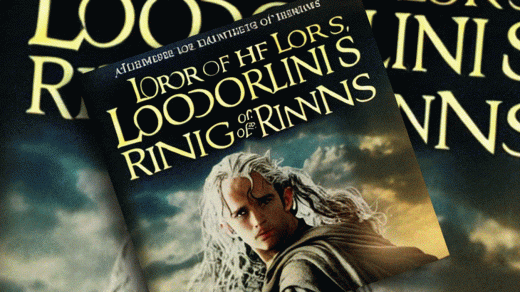Pop culture itself is plunging into bizarro alternate realities
Your day is about to dissolve along with your brain into a whirlpool of marvelous idiocy and deranged beauty when you go to Lexica.art, which is simply the best, most amazewrong image search engine on the internet right now. It just made me spend two hours digging through visual content that provoked an infinite cycle of awe, disgust, bewilderment, and just plain amazement as I saw our universe getting warped by text-to-image artificial intelligence and its users’ wicked minds.
Self-ascribed as “The Stable Diffusion Search Engine,” Lexica.art delivers on the obvious implications of its title. I’m well acquainted with Stable Diffusion’s AI text-to-image creation system and how crazy things can get, but I was not prepared for the uncanny valley that is tapping into the scream of consciousness brought into the light by this search engine. Lexica.art allows you to type anything you want in order to see what resulted from all the related prompts—the plain-language words that guide Stable Diffusion (SD) to build an image—painstakingly created by users worldwide. And, in the resulting visual torrent, you can instantly grasp two things. One, that humanity’s collective mind lives in a Terry Gilliam movie; and two, that AI is the perfect carnival mirror to twist pop culture in a billion ways to highlight its inherent absurdity.
Allow me to demonstrate. Here are the first several examples of a never-ending flow of images that filled my screen as I typed the first thing that came to my mind: “Lord of the Rings.”
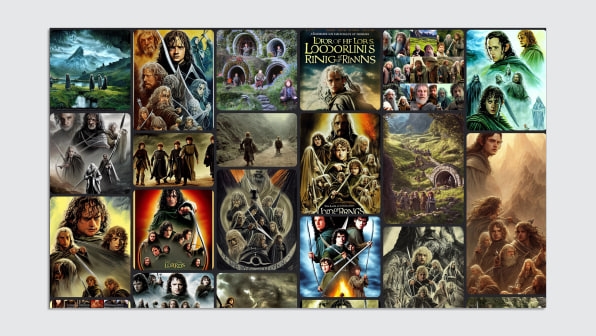
A portal opened to multiple movies from alternate realities, in which every character is as ugly as Gollum just out of the shower. It made me stop sipping my cup in disbelief until I focused on this picture, which made coffee burst out of my nose in laughter:

The absurdity of the title. The young Kevin Bacon with mop hair. The sadness and despair I imagined on the face of the fanboy/girl who waited with bated breath after typing the prompt only to receive this image. It was horrible. It was beautiful. And it only got better when I realized I could click on the picture and read the prompt itself, which is even better than the visual: “Photo of the steamy new romance novel lord of the rings.” That kind of made me laugh and hurt a bit at the same time, but I pressed on.
I instantly realized that there are likely millions of bizarro pop culture icons quietly waiting behind that search field, all grinning with their monster smiles and counterfeit suits. So I started to frantically type queries one after the other. I went to “Star Wars” next, of course.
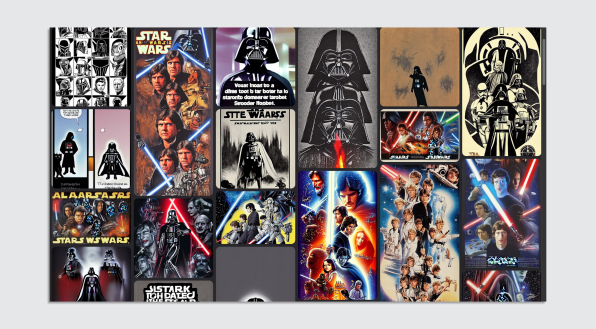
STARS WSWARS. ALAASEASRS. I saw a version in which all characters are Mark Hamill. One where Mark Hamill—and everyone else—was Mark Zuckerberg. I scrolled down trying to focus. I couldn’t because there are no obvious winners in this wonderland of craze. It’s like someone fused Warhol’s and Duchamp’s brains inside the machine, then gave them LSD. I jumped to “Mad Men,” because why not?
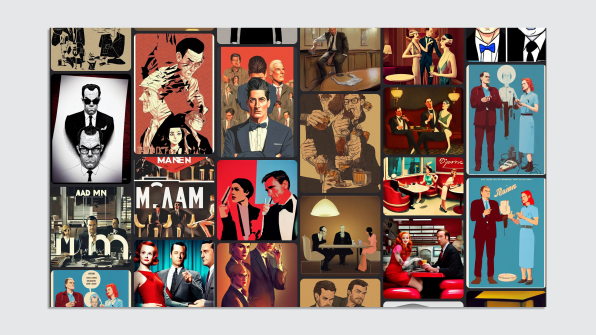
I spotted the prompt “Polaroid picture, sepia, homeless jon hamm in the streets of los angeles, unshaved, toothless, next to a tent, symmetrical face, fine details, day setting, ethereal, trending on artstation.” Someone in Hollywood trying to pitch a series, no doubt:
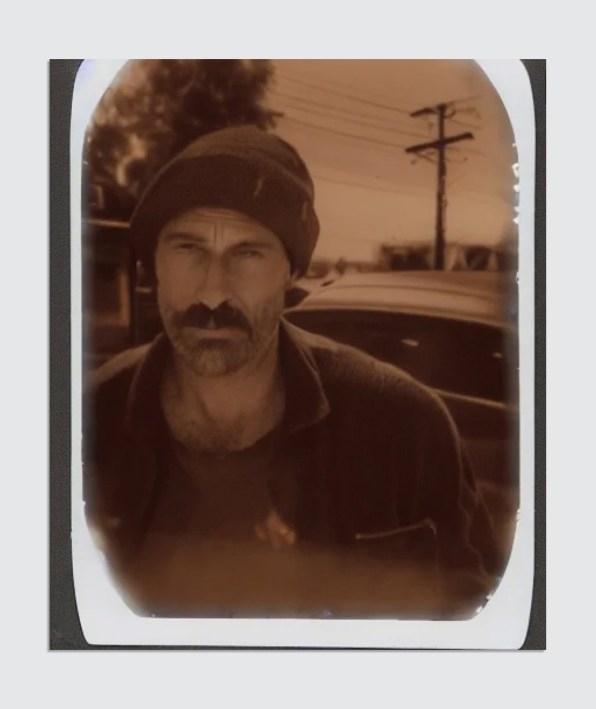
I tried “the Beatles.”
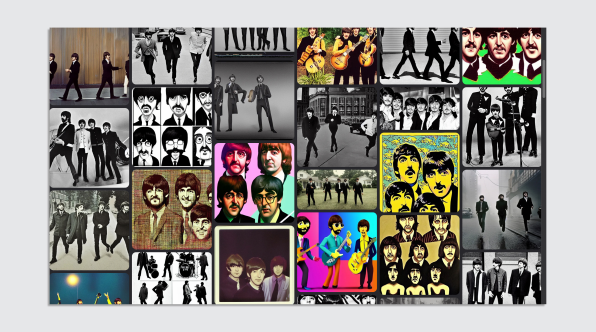
I tried “Mickey Mouse.”
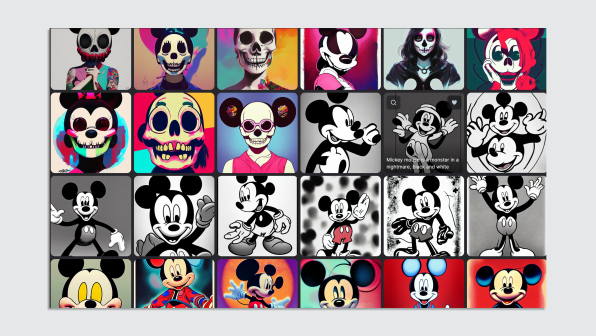
I kept trying and trying. I couldn’t stop. The nightmares exploded when I typed “McDonald’s”:
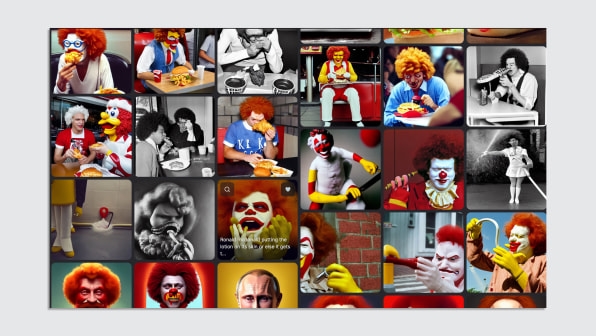
After a while I started to realize that this was more than just fun and more than just horror: Stable Diffusion is birthing a multiverse of alternate realities, all distilled from the very personal visions of tens (hundreds?) of thousands of fans who probably jumped at the possibility of realizing their most intimate dreams with text-to-image technology. At last, a place to materialize their inner desires, the eternal fictions that populate the brains of everyone who ever had a favorite thing!
This phenomenon touched me. I’m a fan myself. I have all the comic books. Series of novels by some very specific writers. Movies that I love. Music I can’t stop listening to. All legends in my mind. And despite all of these realities having the uncanny valley quality of text-to-image AI—still in its infancy—they represent the dreams of others. I could see people using it to express themselves in a way that maybe they can’t do in the real world. One prompt, for instance, read “all Black cast Star Wars.”
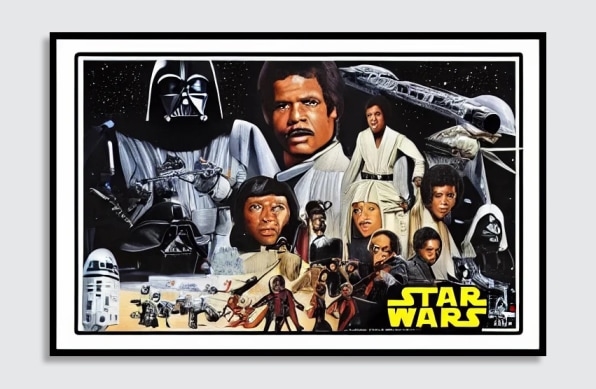
Behind these amusements lives a world of more intimate intentions. I remembered the prompt from the beginning of my searches: “Photo of the steamy new romance novel lord of the rings.” Many of these prompts felt real and raw—and I almost felt dirty reading them, as if I had sneaked into someone’s bedroom to rummage through their drawers. Perhaps, I thought, people are using Stable Diffusion not only to make Hollywood pitches and create memes and absurd illustrations, but also so they can express themselves. To see what they want to realize with their own eyes because they don’t have the artistic ability to make it real. If you can’t write fanfic or draw a comic book, perhaps SD can be the tool to make your wishes and needs come true, instantly.
If we can use these technologies to cast a new vision of our cultural icons based on our wishes and realities, what will happen to us and our culture? What could we discover and say about ourselves, as individuals and as a human species, as we mold the dreams and ideas of others to fit our wants? It seems clear to me that in a not-so-far future we will be able to synthesize complex worlds—based on our thoughts, on what we know, what we love, and what we hate—to immerse ourselves and others. Perhaps we will be able to process a movie in real time so it fits what we, as individuals, really want to see.
And yes, most of this new personal pop culture may end up being crap (as crap as the original inspiration material, anyway), and most of it will be variations of the prequels and sequels and endless seasons and reboots that Hollywood and everyone else already churns out. But haven’t we been remixing the same old tales again and again through ages and cultures? Isn’t Luke Skywalker just Gilgamesh or Prometheus with a terrible haircut and a lightsaber? It doesn’t matter. Star Wars with an all-Black cast will come—whether Disney sanctions it or not—just there’s sure to be a Lord of the Rings featuring a steamy polyamorous romance between Frodo, Sam, and Aragorn.
Lexica.art provides a formidable vision of a weird and wonderful new adventure that is coming. One that will have, I can only imagine, profound consequences for all of us, the shared experiences that shape our culture, and our very sense of reality—and its potential self-destruction into infinite personal experiences. May we all meet soon in the world of the “Loror of hf Lors, Loooodorlinis Rinig of of Rinnns.” Amen.
(18)

